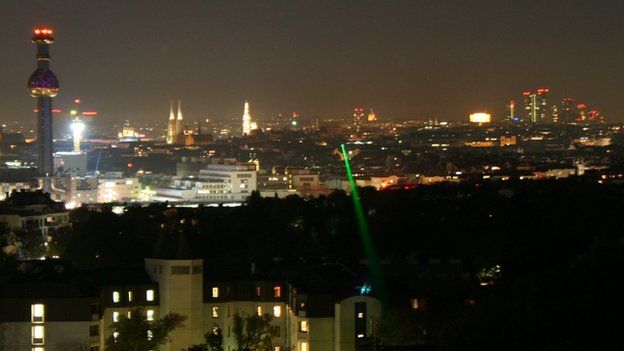'Twisted light' beamed across Vienna
- Published

Physicists have sent a beam of twisted light 3km through the air above Vienna.
It is the first time that information has been transmitted outdoors using the "twist" of a visible light beam.
This twisting property could allow very fast communication because light with different amounts of twist, encoding separate channels of information, could be sent simultaneously.
Reported in the New Journal of Physics, the technique was tested by sending three images of famous Austrians.
The images were black-and-white portraits of the physicists Ludwig Boltzmann and Erwin Schroedinger, and composer Wolfgang Amadeus Mozart.
Above the rooftops of Mozart's own city, where the only long-range signal known to the famous composer would have been church bells, his portrait was broken down into pixels and travelled through the night inside a green laser beam.
Twisted, twice
The twisting of light, technically described as its "orbital angular momentum" (OAM), was first demonstrated in the 1990s and so would probably have surprised the two famous physicists as well.
Rather than polarised light waves, which are restricted in the directions that they can "wiggle", light with this type of momentum twists through space like a corkscrew.
In terms of individual photons of light, it means that instead of spinning like the Earth around its own axis, their energy traces out a spiral. It is the same sort of momentum that sees the Earth orbit the sun, but the photons are also moving forward at the speed of light.
That corkscrew-like motion is useful because instead of just having two possible directions like polarisation (clockwise or anticlockwise), it can turn in either direction with a potentially infinite number of twists - much like a screw with multiple threads.
This is why physicists have been investigating whether twisted light could help transmit information very quickly: each twist configuration could be its own channel, just like different colours of light inside an optical fibre.
In the new study, however, there were no cables. Researchers from the University of Vienna set up a green laser at the window of a tower, and shone it onto a spatial light modulator. This gadget, which consists of a specially controlled liquid crystal display (LCD), put two different twists on the light that it reflected and sent across the city.
"We didn't directly use the OAM itself, but a superposition of two angular momentums, which go in opposite directions," said lead author Mario Krenn, a PhD student at the university's Institute for Quantum Optics and Quantum Information.
By adding two opposing twist to the laser beam, he and his colleagues gave it a specific structure that could be detected when the light hit a screen just over 3km away, on the roof of their institute.
The beam became a ring of dots, and the number of dots was determined by how much the light was twisted.
"Then you can tell, from the physical arrangement [of dots on the screen], what OAM the light has," Mr Krenn explained.
Withstanding the weather
He told the BBC the team "really didn't know" whether their idea would work. "We were definitely very surprised that it worked so well."
Once they had seen a green, flower-like pattern appear on their screen, even after travelling 3km through the evening air, they set about transmitting some actual information.
They made 16 different beam structures, using different amounts of twist, and used them to encode 16 different levels of grey. Then, one pixel after another, they sent the encoded portraits along the laser beam.
At the receiving end, a camera and a computer program recognised the patterns, and re-created the pictures with an error rate of only 1.7%.
The researchers hope that their results, although preliminary, will help the development of OAM technology for applications like Earth to satellite communication.
Other physicists have greeted the findings with enthusiasm.
"This is a proof of principle for how to encode and decode the 16 different channels," said Dr Michael Mazilu, a lecturer in the school of physics and astronomy at the University of St Andrews.
"It's a step towards encoding more information in less light."
Mark Neil, a professor of photonics at Imperial College London, was impressed the team had overcome the problem of turbulence in the air.
"The big problem was... if you tried to put [twisted light] through a normal atmosphere - you don't have to go very far and it messes up all these OAM modes, and it's difficult to work out what's going on," Prof Neil told BBC News.
"So this is quite interesting because they have found a way of unravelling the different modes. They're sending patterns that they can detect."
Prof Miles Padgett, who studies twisted light at the University of Glasgow, also said that overcoming turbulence was a major problem that the Vienna study had now begun to address.
"It's lovely work," he said. "It shows the potential of the system, and it characterises the problems that people now need to work to overcome."
Earlier research had demonstrated that radio waves, twisted in the same way, could simultaneously carry two channels of information 442m across a Venice canal. But work with visible wavelengths of light, with more high-energy photons, was limited to indoor experiments which reached very high rates of data transfer but only travelled short distances,
The portraits beamed across Vienna didn't break any speed records. Because the pixels were sent one-by-one, each picture took several minutes.
They did, however, travel 3km through the open air.
"We were still excited," Mr Krenn said. "It's a proof of concept."
Follow Jonathan on Twitter
- Published28 June 2013
- Published8 November 2012
- Published25 June 2012
- Published2 March 2012
- Published14 February 2011